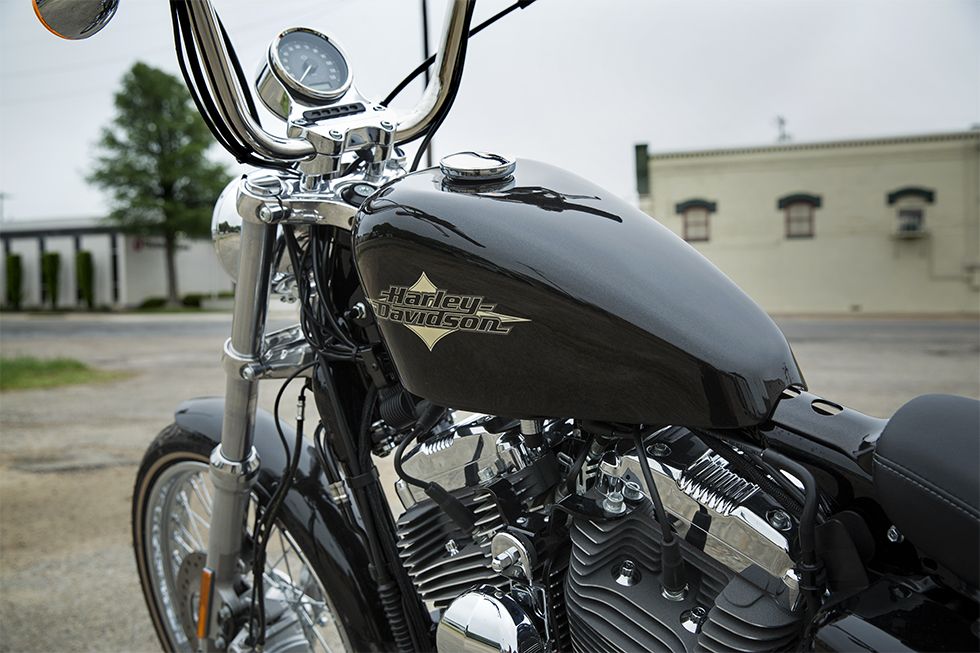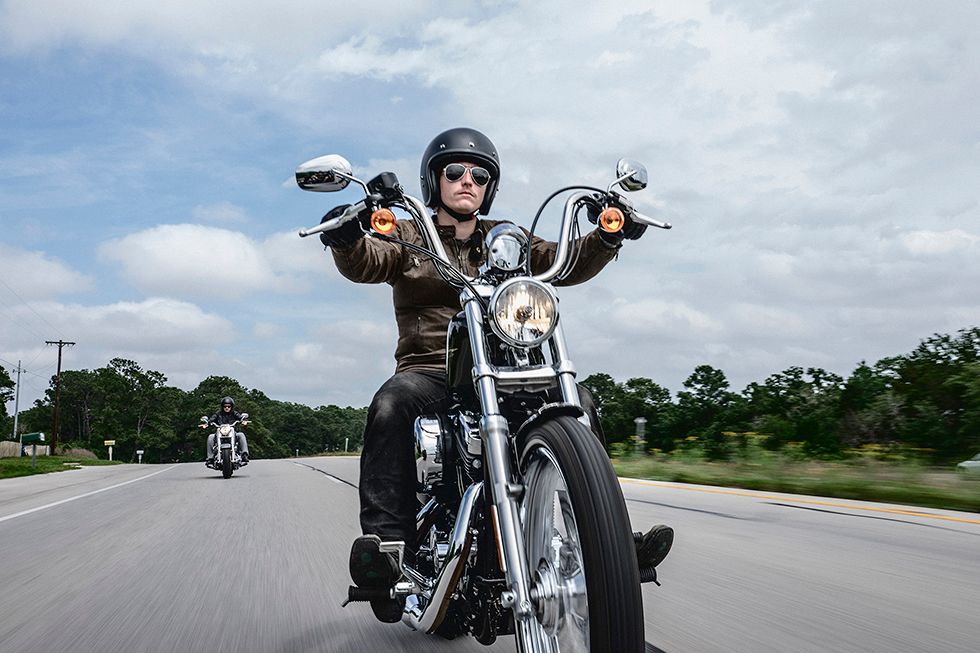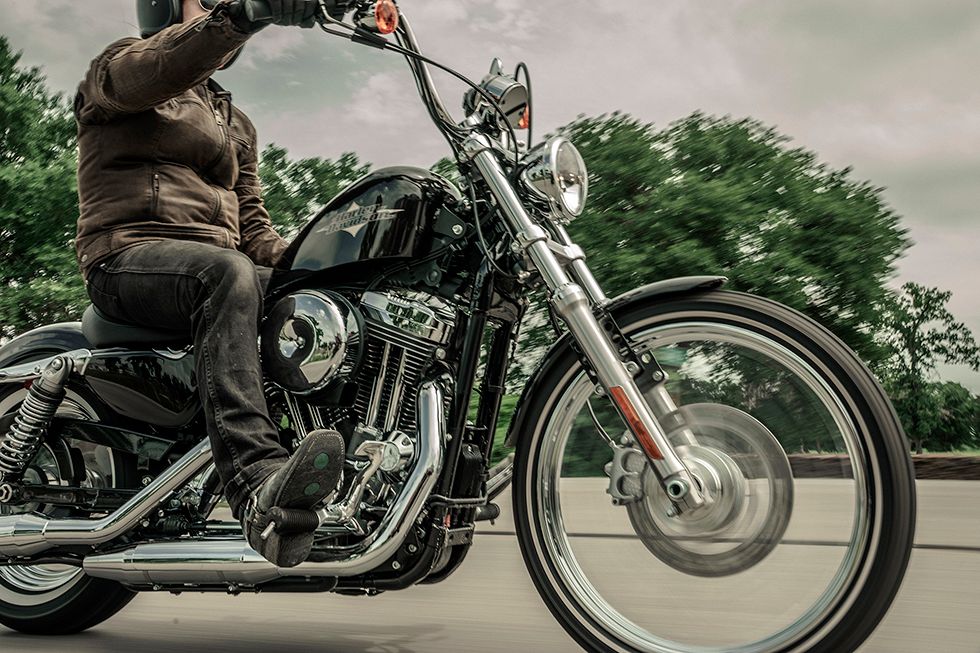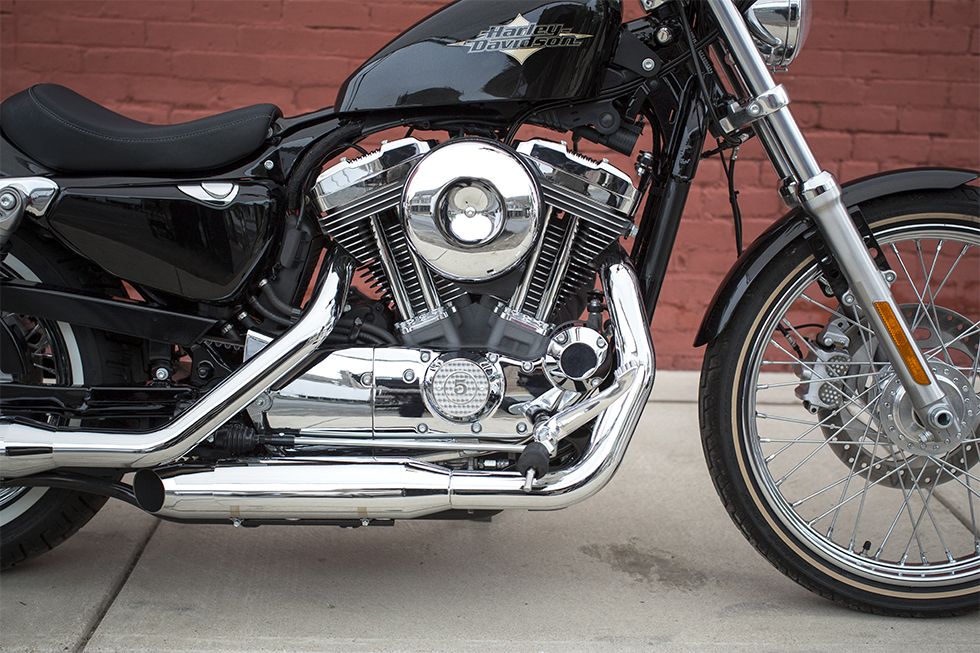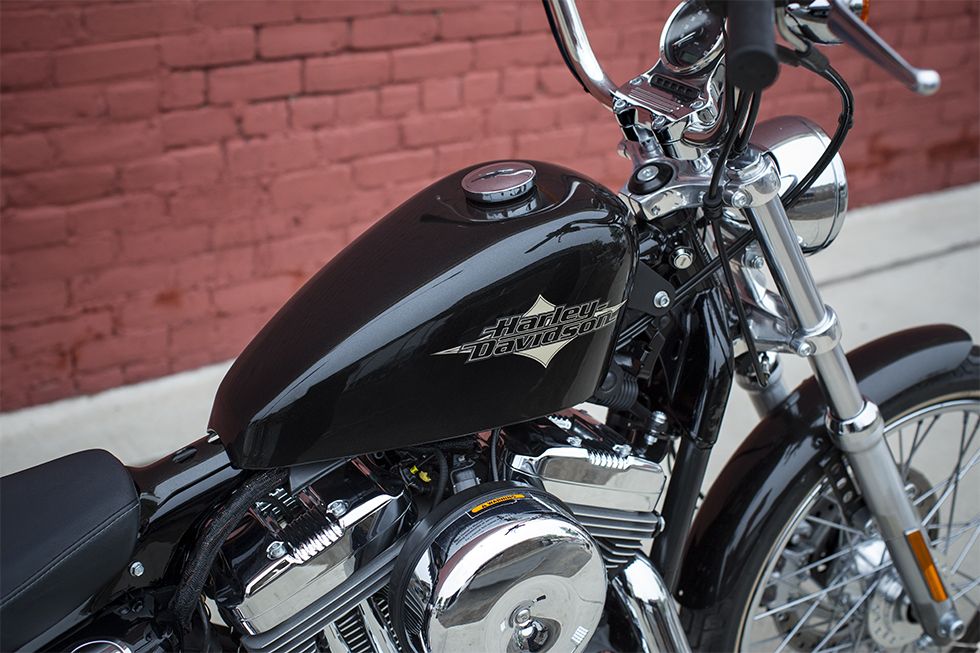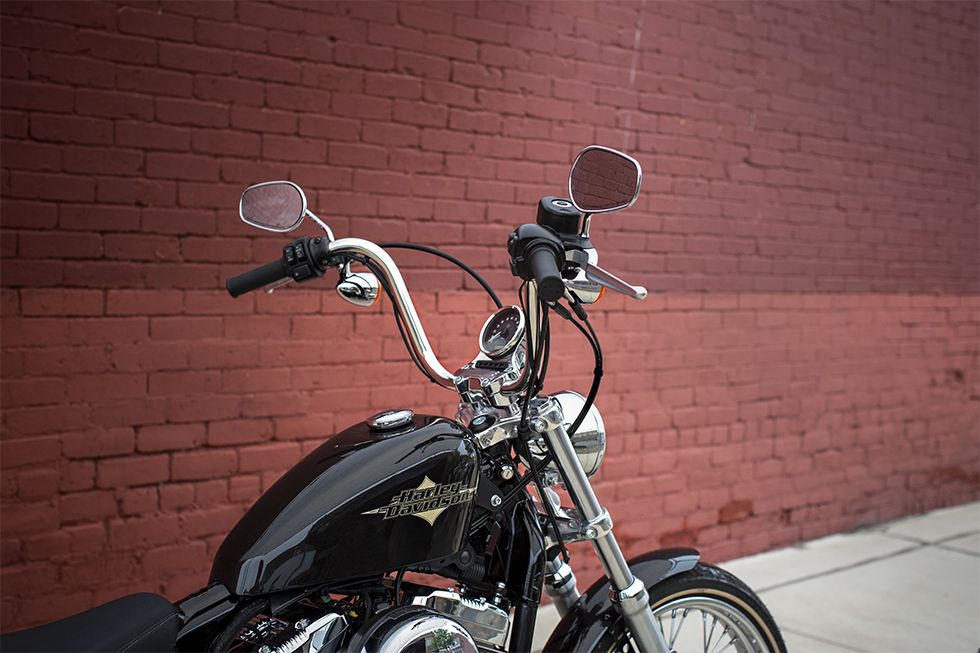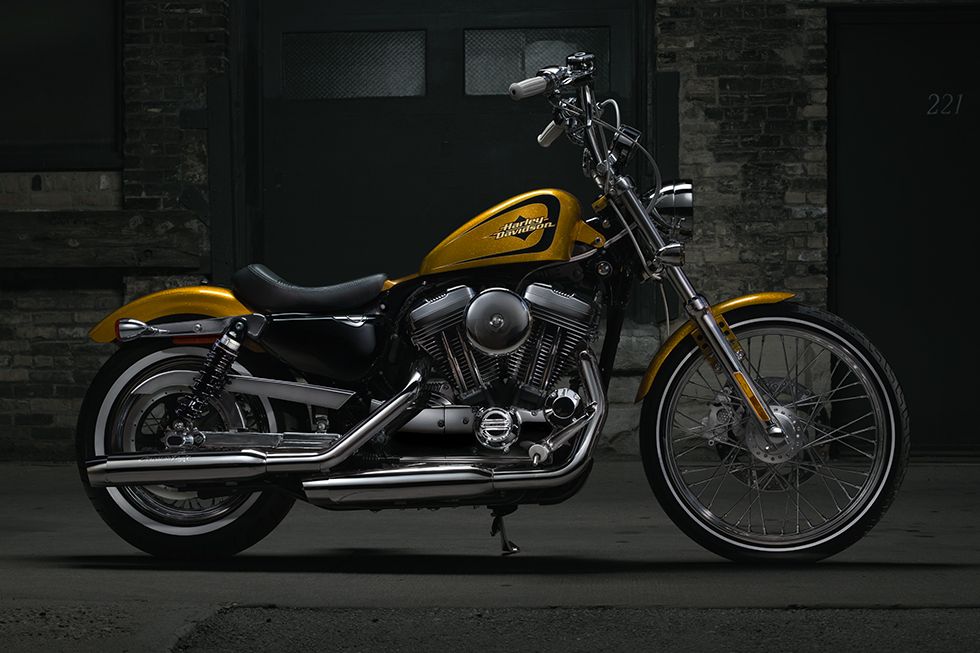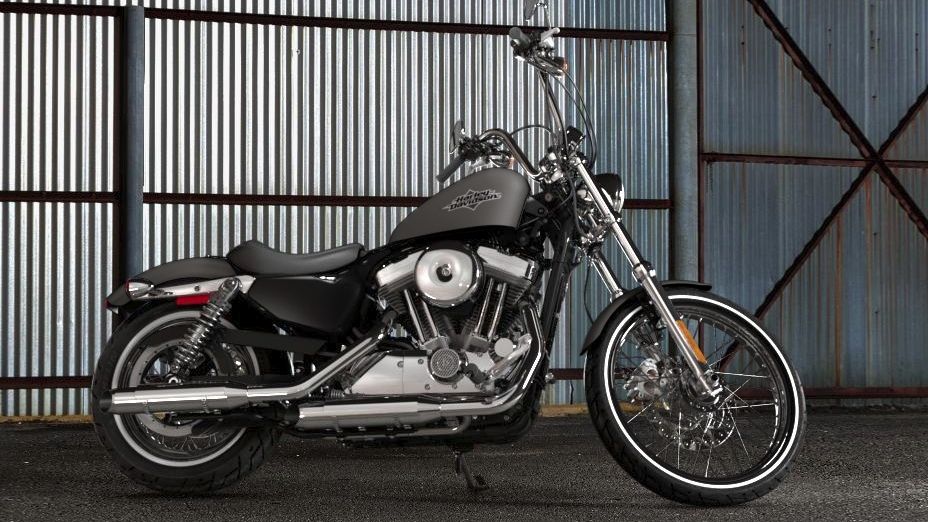The Evolution Sportster->ke1818 has been around for a minute, since 1986 in fact, a bit too late for the custom->ke296 craze of the '70s. It was born into a world of changing attitudes about motorcycling in general, and a burgeoning new market among the so-called “Rich Urban Biker” crowd. You know, the folks that ten years prior would have rolled up their windows and locked their doors when a Harley->ke300 pulled up next to them at a light, and couldn't change a needle-valve if you held a cocked 1911 to their head. Catering to this crowd was a smart move by the Company, 'cause if you want to make money, you have to make a product for people who have money.
While the Evo Big-Twins -- most notably the Softails->ke1819 -- benefited early from efforts to tie into Harley's deep roots, Sportster design sort of stagnated, seemingly satisfied to continue the general design characteristics established by the K-model in 1952, and subsequent Ironhead Sportsters up through '85, with minor variations. Fast-forward to 2016, and the Sportster Seventy-Two that plumbs the depths of the outlaw/custom culture of the '70s, a look that is now once again in vogue with the New Guard, and has shed a lot of the stigma attached to the originals.
Continue reading for my review of the 2016 Harley-Davidson Seventy-Two.
harley-davidson-seventy-two
- Make: Array
- Model: harley-davidson-seventy-two
Harley-Davidson Seventy-Two
- Make: Array
- Model: Harley-Davidson Seventy-Two
- Engine/Motor: V-Twin
- [do not use] Vehicle Model: Array
Design
Much like the Forty-Eight->ke3618, the Seventy-Two doesn't follow any specific historical model, but instead captures the vibe of an entire era when choppers->ke2288 were central to the custom culture prevalent at the time. The look starts with the front end, where the 21-inch laced rim, cut down fender with drilled supports and skinny whitewalls set the tone for the rest of the bike.
While not really a chopper, the 30.1-degree rake and front forks combine with the front wheel diameter to raise the front of the frame a bit higher than the back, leaving the suggestion of having been stretched. But it's just an illusion that dies as soon as you notice the minimal clearance between the rocker boxes and the tank. Yeah, I know the factory was going for a certain vibe and not necessarily a faithful reproduction, but c'mon Harley, would it kill you to actually give the downtubes a few inches of stretch and really make it look like a proper chopper? (What can I say, I'm something of a perfectionist.)
That aside, the mini-apes add to the height at the front end, and bolster the really stretched look. A classic 2.1-gallon peanut tank, chopped rear fender and forward-ish controls complete the ensemble.
faux0}
The bones are typical Harley, with thick-walled steel tubing forming a double-downtube, double-cradle frame with a stiff and heavy backbone running under the tank and seat. It's fairly low too, with 5.2-inches of ground clearance and a laden seat height just shy of 27 inches; good news for riders requiring a short trip from seat to ground.
Front forks come right-side up for that traditional look, and the beefy 39 mm tubes keep the front wheel stable and prevent the front of the bike from looking too skinny. A coil-over rear shock comes with emulsion technology and a screw adjuster for quick and easy changes to the damping action. Footpeg brackets pull the forward controls back just a skosh from the “usual” position even with the turn of the downtubes, but the front exhaust pipe prevents that truly forward position, and the revised position is more comfortable to shorter riders, and ones unaccustomed to riding in a feet-forward windsock position.
Dual-piston calipers front and rear bind the wheels, and at 559 pounds soaking wet, the lack of dual front brakes isn't that big of a deal, and I can't blame Harley for not wanting to cover up that big, beautiful laced wheel. ABS is available as an option, so you can take it or leave it as you wish.
Drivetrain
The Evolution Sportster engine has been around for 30 years now. If you equate longevity with success, then this is Harley's most successful engine family to date. The factory has had plenty of time to tweak and improve what is already a solid powerplant. Best of all, the engine shape (if not all the details) falls right in line with the target era, and so it compliments the overall look, rather than competing with it. The mill comes purely air cooled, with none of the Twin-Cam's twin-cooling technology (yet?), and the undersquare, long-stroke engine displaces 73.4 cubic-inches (1,202.8 cc), and generates 70.8 pound-feet of torque at 3,500 rpm.
While torque has long been an intrinsic benefit of Harley's 45-degree engine layout, the electronic fuel injection helps improve grunt while reducing emissions and keeping mileage around the 48 mpg mark. Much like the older carbureted models, you can slap a Stage-1 (Harley tax) on it to open her up a bit, or progress through the Stage-3 if you are a real fiery-eyed pegdragger. A five-speed, constant-mesh transmixxer provides decisive shifts, and keeps the rpm reasonable on the highway while maintaining the holeshot capability Sporties are known for.
Price
As usual, the price breaks down according to color choice. You can ride off on the Charcoal Denim, Black Denim or Black Quartz model for $11,099, or opt for the Hard Candy Gold Flake or Hard Candy Black Gold Flake at $11,849. ABS will run you $795, and the security option another $395, plus $360 in freight. I'm sorry California brothers and sisters in-the-wind, your emissions package will tack another Ben Franklin onto the ticket.
Competitor
Since the Sportster is somewhat unique in size, shape and displacement, it's difficult to find an apples-to-apples competitor, and, as usual, the Bolt from Star presents the closest example I could find. Granted, the Bolt doesn't enjoy the same historical ties as the Seventy-Two, nor the nostalgic look, a clever individual could customize the Bolt to bring it closer to the panache of this particular Harley.
First, let's look at the engines. The Bolt runs a 58 cubic-inch (942 cc) mill, placing it a little shy of the H-D's 73.4 cubic-inch (1,202.8 cc) plant, but at least it too is air-cooled, so there is no radiator to wreck the looks. Additionally, the Star runs with a SOHC valvetrain, which is arguably a better setup than the pushrod-driven alternative, but it lacks the same charm. Though Star gives up no dyno data, I promise it doesn't put out torque like the H-D.
As far as rider suitability, both are low and light, with easy ground access when it's time to deploy your training wheels. Bottom line here is: any rider capable of riding anything bigger than a scooter, more or less, should be able to manage either bike and neither enjoys any significant advantages here.
Price and color availability is a mixed bag. While the Bolt is undeniably the more economical of the two at $7,990 -- well under the 11k-plus sticker on the Harley -- color selection is something of a yawn with a blue or black tank over a blackout chassis and engine. Yeah, I know that Harley has long been the benchmark for spectacular paint -- a well-deserved reputation, I might add -- but the color selections on the Seventy-Two are as cheese-to-chalk by comparison. I just wish H-D wasn't so proud of it. Oh well, the painter's kids have to eat, too.
He Said
"I like to ride Sportys, and I like to look at choppers, and ne'er the twain shall meet! Having ridden choppers before, I consider them to be deathtraps more suited for the showroom than the highway. Maybe the moderate rake and lack of stretch isn't such a bad thing after all, since the bike gets some of the look and curb appeal with none of the adverse handling characteristics. (Yes, I can be contrary when it suits me.) Still, I appreciate that Harley is making the Sportster line more diverse, and I love the historical bent of the Seventy-Two, and its sibling the Forty-Eight. I look forward to seeing the next efforts from Harley to recapture its vintage/custom/outlaw history.”
She Said
My wife and fellow writer, Allyn Hinton, says, "When I looked at the Bolt R-Spec->ke2288, I made comparisons to the Seventy-Two. The Bolt has the same engine as the V Star 950 and it's a nice bike, especially for beginners. I'm not feeling the skinny front tire and almost-stretched look of the Seventy-Two. It's probably my least favorite Harley; but performance-wise, it's right there."
Specifications
|
Drivetrain: |
|
|
Engine: |
Air-cooled, Evolution® |
|
Displacement: |
73.4 cubic inches (1,202 cc) |
|
Bore: |
3.5 inches (88.9 mm) |
|
Stroke: |
3.811 inches (96.8 mm) |
|
Compression Ratio: |
10:01 |
|
Fuel System: |
Electronic Sequential Port Fuel Injection (ESPFI) |
|
Primary Drive: |
Chain, 38/57 Ratio |
|
Gear Ratios (overall) : |
1st: 9.315, 2nd: 6.653, 3rd: 4.948, 4th: 4.102, 5th: 3.517 |
|
Exhaust: |
Chrome dual shorty exhaust |
|
Chassis: |
|
|
Suspension, Front: |
39mm fork with cartridge damping |
|
Suspension, Rear: |
emulsion rear shock with screw adjuster |
|
Wheels, Front Type: |
Chrome Steel Laced w/ Custom Whitewall Tires |
|
Wheels, Rear Type: |
Chrome Steel Laced w/ Custom Whitewall Tires |
|
Brakes, Caliper Type: |
Dual-piston front, Dual-piston rear |
|
Tires, Front: |
MH90-21 54H |
|
Tires, Rear: |
150/80B16 71H |
|
Performance: |
|
|
Engine Torque Testing Method: |
J1349 |
|
Engine Torque: |
70.8 Pound-Feet at 3,500 rpm |
|
Lean Angle, Right: |
28.6 degrees |
|
Lean Angle, Left: |
29.8 degrees |
|
Electric: |
|
|
Lights (as per country regulation), Indicator Lamps: |
High beam, neutral, low oil pressure, turn signals, engine diagnostics, low fuel warning, low battery, security system (optional) |
|
Gauges: |
Electronic speedometer with odometer, time-of-day clock on odometer, dual tripmeter, LED indicator lights |
|
Dimensions: |
|
|
Length: |
89.6 inches |
|
Seat Height, Laden: |
26.9 inches |
|
Seat Height, Unladen: |
28.5 inches |
|
Ground Clearance: |
5.2 inches |
|
Rake (steering head) : |
30.1 degrees |
|
Trail: |
5.3 inches |
|
Wheelbase: |
60.6 inches |
|
Details: |
|
|
Fuel Capacity: |
2.1 gallons |
|
Fuel Economy: |
48 mpg |
|
Oil Capacity (w/filter) : |
2.8 Quarts |
|
Dry Weight: |
546 Pounds |
|
Wet Weight: |
559 Pounds |
|
Colors: |
Black Quartz, Black Denim, Charcoal Denim, Hard Candy Gold Flake, Hard Candy Black Gold Flake |
|
Price: |
Color Option $11,099, Hard Candy Color Option $11,849 |


